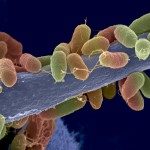Link to Pubmed [PMID] – 22246638
Proteomics 2012 Feb;12(4-5):651-65
Biofilms are surface-attached, matrix-encased, structured microbial communities which display phenotypic features that are dramatically different from those of their free-floating, or planktonic, counterparts. Biofilms seem to be the preferred mode of growth of microorganisms in nature, and at least 65% of all human infections are associated with biofilms. The most notable and clinically relevant property of biofilms is their greater resistance to antimicrobials compared with their planktonic counterparts. Although both bacterial and fungal biofilms display this phenotypic feature, the exact mechanisms underlying their increased drug resistance are yet to be determined. Advances in proteomics techniques during the past decade have facilitated in-depth analysis of the possible mechanisms underpinning increased drug resistance in biofilms. These studies have demonstrated the ability of proteomics techniques to unravel new targets for combating microbial biofilms. In this review, we discuss the putative drug resistance mechanisms of microbial biofilms that have been uncovered by proteomics and critically evaluate the possible contribution of the new knowledge to future development in the field. We also summarize strategic uses of novel proteomics technologies in studies related to drug resistance mechanisms of microbial biofilms.

